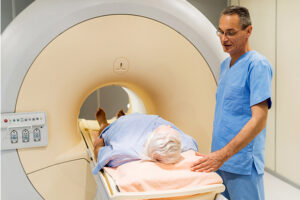Oncology
Prostate Cancer
Optimization of Whole-Patient Care in Advanced Prostate Cancer
Overview
Quality of life (QOL) and overall survival (OS) are 2 end points that are very important to patients with advanced prostate cancer. Our featured expert considers the ways in which optimizing whole-patient care can improve both.
Expert Commentary
Daniel J. George, MD
|
|
“As patients achieve disease control and respond to our treatments, we are presented with what I consider to be one of the best opportunities to then complement that care with whole-patient care optimization.”
As oncologists, we publish and read studies about specific tumor types, and our lexicon is often geared toward the tumor. At times, our sights may be focused too much on the tumor and not enough on the whole patient. To me, whole-patient care encompasses 2 things that matter most to patients: QOL and OS. The distinction between OS and disease-specific survival is an important one in that our treatments must prolong prostate cancer–specific survival without contributing to another cause of mortality that would shorten OS.
Additionally, whole-patient care is very important throughout the course of disease (ie, in both early and advanced settings). We should remain mindful of the risks associated with prostate cancer therapies and how those risks may manifest differently in a real-world population as opposed to that of a clinical trial. This is particularly true when hormonal therapies are intensified or are used earlier in the disease course, as well as later on, when chemotherapies or radioligand therapies are layered in.
Having a multidisciplinary plan in place helps to cover all aspects of care. Optimizing our patients’ cardiac status, diabetes control, functional status, strength and conditioning, diet, and sleep can be critical to both survival and QOL. Thus, thinking of ways to optimize QOL while helping patients to live longer is critical. This may include encouraging patients to exercise, as strength and conditioning in specific areas can reduce the risk for precipitating falls (eg, central muscles and gluteus). Exercises for the gluteus, hip, and pelvic muscles are very different from those for the arms, biceps, and lower extremities, and patients may need guidance. It is also important to be proactive about the risk of neuropathy and managing the arthritic causes of neuropathy. The same is true with the metabolic conditions, high blood pressure, and other aspects of general health.
Taking on whole-patient care can be challenging because we have so much to talk about with our patients in terms of their cancer. However, as patients achieve disease control and respond to our treatments, we are presented with what I consider to be one of the best opportunities to then complement that care with whole-patient care optimization.
References
Gillessen S, Attard G, Beer TM, et al. Management of patients with advanced prostate cancer: report of the Advanced Prostate Cancer Consensus Conference 2019. Eur Urol. 2020;77(4):508-547. doi:10.1016/j.eururo.2020.01.012
Sade JP, Báez CAV, Greco M, et al. Optimizing the treatment of metastatic castration-resistant prostate cancer: a Latin America perspective. Med Oncol. 2018;35(4):56. doi:10.1007/s12032-018-1105-8
Scotté F. The importance of supportive care in optimizing treatment outcomes of patients with advanced prostate cancer. Oncologist. 2012;17(suppl 1):23-30. doi:10.1634/theoncologist.2012-S1-23
Shore ND, Drake CG, Lin DW, et al. Optimizing the management of castration-resistant prostate cancer patients: a practical guide for clinicians. Prostate. 2020;80(14):1159-1176. doi:10.1002/pros.24053











